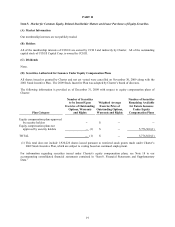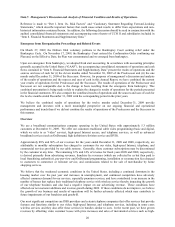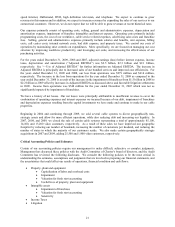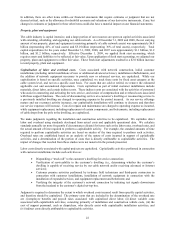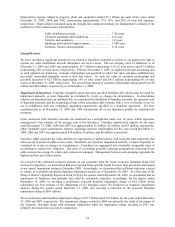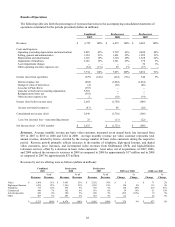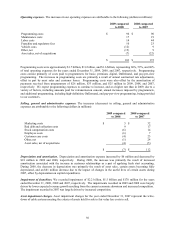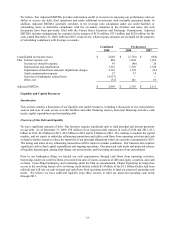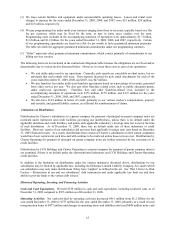Charter 2009 Annual Report Download - page 28
Download and view the complete annual report
Please find page 28 of the 2009 Charter annual report below. You can navigate through the pages in the report by either clicking on the pages listed below, or by using the keyword search tool below to find specific information within the annual report.
25
Fresh start accounting. On the Effective Date, we applied fresh start accounting and adjusted our franchise,
goodwill, and other intangible assets including customer relationships to reflect fair value. Our valuations, which
are based on the present value of projected after tax cash flows, resulted in a value for property, plant and
equipment, franchises and customer relationships for each unit of accounting. As a result of applying fresh start
accounting, we recorded goodwill of $951 million which represents the excess of reorganization value over amounts
assigned to the other assets. For more information, see Note 2 to the accompanying consolidated financial
statements contained in “Item 8. Financial Statements and Supplementary Data.”
We determined the estimated fair value of each unit of accounting utilizing an income approach model based on the
present value of the estimated discrete future cash flows attributable to each of the intangible assets identified for
each unit assuming a discount rate. This approach makes use of unobservable factors such as projected revenues,
expenses, capital expenditures, and a discount rate applied to the estimated cash flows. The determination of the
discount rate was based on a weighted average cost of capital approach, which uses a market participant’ s cost of
equity and after-tax cost of debt and reflects the risks inherent in the cash flows.
We estimated discounted future cash flows using reasonable and appropriate assumptions including among others,
penetration rates for basic and digital video, high-speed Internet, and telephone; revenue growth rates; operating
margins; and capital expenditures. The assumptions are derived based on Charter’ s and its peers’ historical
operating performance adjusted for current and expected competitive and economic factors surrounding the cable
industry. The estimates and assumptions made in our valuations are inherently subject to significant uncertainties,
many of which are beyond our control, and there is no assurance that these results can be achieved. The primary
assumptions for which there is a reasonable possibility of the occurrence of a variation that would significantly
affect the measurement value include the assumptions regarding revenue growth, programming expense growth
rates, the amount and timing of capital expenditures and the discount rate utilized. The assumptions used are
consistent with current internal forecasts, some of which differ from the assumptions used for the annual impairment
testing in December 2008 as a result of the economic and competitive environment discussed previously. The
change in assumptions reflects the lower than anticipated growth in revenues experienced during 2009 and the
expected reduction of future cash flows as compared to those used in the December 2008 valuations.
Franchises, for valuation purposes, are defined as the future economic benefits of the right to solicit and service
potential customers (customer marketing rights), and the right to deploy and market new services, such as
interactivity and telephone, to potential customers (service marketing rights). Fair value is determined based on
estimated discrete discounted future cash flows using assumptions consistent with internal forecasts. The franchise
after-tax cash flow is calculated as the after-tax cash flow generated by the potential customers obtained (less the
anticipated customer churn), and the new services added to those customers in future periods. The sum of the
present value of the franchises' after-tax cash flow in years 1 through 10 and the continuing value of the after-tax
cash flow beyond year 10 yields the fair value of the franchises. Franchises increased $62 million as a result of the
application of fresh start accounting. Subsequent to finalization of the franchise impairment charge and fresh start
accounting, franchises are recorded at fair value of $5.3 billion. Franchises are expected to generate cash flows
indefinitely and as such will continue to be tested for impairment annually.
Customer relationships, for valuation purposes, represent the value of the business relationship with existing
customers (less the anticipated customer churn), and are calculated by projecting the discrete future after-tax cash
flows from these customers, including the right to deploy and market additional services to these customers. The
present value of these after-tax cash flows yields the fair value of the customer relationships. We recorded $2.4
billion of customer relationships in connection with the application of fresh start accounting on the Effective Date.
Customer relationships will be amortized on an accelerated method over useful lives of 11-15 years based on the
period over which current customers are expected to generate cash flows.
Sensitivity. As a result of the impairment of franchises taken in 2009 and the application of fresh start accounting,
the carrying values of franchises and other intangible assets were re-set to their estimated fair values as of November
30, 2009. Consequently, any decline in the estimated fair values of intangible assets would result in additional
impairments. It is possible that such impairments, if required, could be material and may need to be recorded prior to
the fourth quarter of 2010 (i.e., during an interim period) if our results of operations or other factors require such
assets to be tested for impairment at an interim date. Management has no reason to believe that any one unit of
accounting is more likely than any other to incur further impairments of its intangible assets.
While economic conditions applicable at the time of the valuations indicate the combination of assumptions utilized
in the valuations are reasonable, as market conditions change so will the assumptions, with a resulting impact on the
valuations and consequently the fair value of intangible assets. For illustrative purposes only, had we used a






